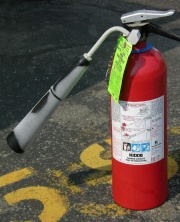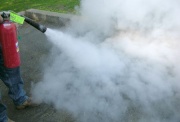Difference between revisions of "Carbon dioxide"
m (Text replace - "== Authority ==" to "== Sources Checked for Data in Record ==") |
|||
| (3 intermediate revisions by the same user not shown) | |||
| Line 1: | Line 1: | ||
| − | [[File:Image3_802517.jpg|thumb|Carbon dioxide | + | [[File:Image3_802517.jpg|thumb|Carbon dioxide fire extinguisher]] |
| − | |||
| − | fire extinguisher]] | ||
== Description == | == Description == | ||
A colorless, odorless gas. Carbon dioxide is naturally produced as a byproduct of respiration, combustion, and decomposition. It has an abundance of 0.027-0.036% in earth's atmosphere. Carbon dioxide is used to make carbonated beverages, aerosol propellants, and fire extinguishers. In museums, it has also been used to create inert, oxygen-free environments to minimize oxidative degradation and to asphyxite insects. Solid carbon dioxide, [[dry ice]], is used for refrigeration and special effects. Liquid carbon dioxide, compressed at high pressures (see [[supercritical fluid]]), has been used as a solvent to remove DDT from artifacts (Kang et al. 2004). | A colorless, odorless gas. Carbon dioxide is naturally produced as a byproduct of respiration, combustion, and decomposition. It has an abundance of 0.027-0.036% in earth's atmosphere. Carbon dioxide is used to make carbonated beverages, aerosol propellants, and fire extinguishers. In museums, it has also been used to create inert, oxygen-free environments to minimize oxidative degradation and to asphyxite insects. Solid carbon dioxide, [[dry ice]], is used for refrigeration and special effects. Liquid carbon dioxide, compressed at high pressures (see [[supercritical fluid]]), has been used as a solvent to remove DDT from artifacts (Kang et al. 2004). | ||
| − | [[File:Image3_802518.jpg|thumb|Carbon dioxide | + | [[File:Image3_802518.jpg|thumb|Carbon dioxide fire extinguisher]] |
| − | |||
| − | fire extinguisher]] | ||
== Synonyms and Related Terms == | == Synonyms and Related Terms == | ||
| Line 14: | Line 10: | ||
carbonic anhydride; fixed gas; carbonic acid gas; dry ice (solid); anhydride carbonique (Fr.); carbondioxid (Dan.); Kohlenstoffdioxid (Deut.); dióxido de carbono (Esp., Port.); dioxyde de carbone (Fr.); anidride carbonica (It.); kooldioxide (Ned.); koolstofdioxide (Ned.); karbondioksid (Nor.); dwutlenek wêgla (Pol.); anidrido carbónico (Port.); koldioxid (Sven.) | carbonic anhydride; fixed gas; carbonic acid gas; dry ice (solid); anhydride carbonique (Fr.); carbondioxid (Dan.); Kohlenstoffdioxid (Deut.); dióxido de carbono (Esp., Port.); dioxyde de carbone (Fr.); anidride carbonica (It.); kooldioxide (Ned.); koolstofdioxide (Ned.); karbondioksid (Nor.); dwutlenek wêgla (Pol.); anidrido carbónico (Port.); koldioxid (Sven.) | ||
| − | == | + | == Risks == |
| + | |||
| + | * Asphyxiating in concentrations over 10%. | ||
| + | * Noncombustible. | ||
| + | * Airgas: [https://www.airgas.com/msds/001013.pdf SDS] | ||
| + | |||
| + | == Physical and Chemical Properties == | ||
Soluble in water forming carbonic acid. pKa = 6.35 and 10.33 | Soluble in water forming carbonic acid. pKa = 6.35 and 10.33 | ||
| Line 27: | Line 29: | ||
|- | |- | ||
! scope="row"| Melting Point | ! scope="row"| Melting Point | ||
| − | | -78.5 | + | | -78.5 C |
|- | |- | ||
! scope="row"| Density | ! scope="row"| Density | ||
| Line 39: | Line 41: | ||
|- | |- | ||
! scope="row"| Boiling Point | ! scope="row"| Boiling Point | ||
| − | | -65 | + | | -65 C |
|} | |} | ||
| − | == | + | == Resources and Citations == |
| − | |||
| − | |||
| − | |||
| − | |||
| − | |||
| − | |||
| − | |||
| − | |||
| − | + | * Sung Mo Kang, Achim Unger, J.J. Morrell, 'The Effect of Supercritical Carbon Dioxide Extraction of Color Retention and Pesticide Reduction of Wooden Artifacts' JAIC 43(2) 151-160, 2004. | |
* G.S.Brady, ''Materials Handbook'', McGraw-Hill Book Co., New York, 1971 Comment: p. 144 | * G.S.Brady, ''Materials Handbook'', McGraw-Hill Book Co., New York, 1971 Comment: p. 144 | ||
| Line 60: | Line 54: | ||
* ''The Merck Index'', Martha Windholz (ed.), Merck Research Labs, Rahway NJ, 10th edition, 1983 Comment: entry 1857 | * ''The Merck Index'', Martha Windholz (ed.), Merck Research Labs, Rahway NJ, 10th edition, 1983 Comment: entry 1857 | ||
| − | * Wikipedia | + | * Wikipedia: http://en.wikipedia.org/wiki/Carbon_dioxide (Accessed Dec. 9, 2005) |
* Susan E. Schur, Conservation Terminology: A review of Past & Current Nomenclature of Materials, ''Technology and Conservation'', Spring (p.34-39); Summer (p.35-38); Fall (p.25-36), 1985 | * Susan E. Schur, Conservation Terminology: A review of Past & Current Nomenclature of Materials, ''Technology and Conservation'', Spring (p.34-39); Summer (p.35-38); Fall (p.25-36), 1985 | ||
Latest revision as of 15:13, 19 May 2022
Description
A colorless, odorless gas. Carbon dioxide is naturally produced as a byproduct of respiration, combustion, and decomposition. It has an abundance of 0.027-0.036% in earth's atmosphere. Carbon dioxide is used to make carbonated beverages, aerosol propellants, and fire extinguishers. In museums, it has also been used to create inert, oxygen-free environments to minimize oxidative degradation and to asphyxite insects. Solid carbon dioxide, Dry ice, is used for refrigeration and special effects. Liquid carbon dioxide, compressed at high pressures (see Supercritical fluid), has been used as a solvent to remove DDT from artifacts (Kang et al. 2004).
Synonyms and Related Terms
carbonic anhydride; fixed gas; carbonic acid gas; dry ice (solid); anhydride carbonique (Fr.); carbondioxid (Dan.); Kohlenstoffdioxid (Deut.); dióxido de carbono (Esp., Port.); dioxyde de carbone (Fr.); anidride carbonica (It.); kooldioxide (Ned.); koolstofdioxide (Ned.); karbondioksid (Nor.); dwutlenek wêgla (Pol.); anidrido carbónico (Port.); koldioxid (Sven.)
Risks
- Asphyxiating in concentrations over 10%.
- Noncombustible.
- Airgas: SDS
Physical and Chemical Properties
Soluble in water forming carbonic acid. pKa = 6.35 and 10.33
| Composition | CO2 |
|---|---|
| CAS | 124-38-9 |
| Melting Point | -78.5 C |
| Density | 1.98 kg/m3 (gas) |
| Molecular Weight | mol. wt. = 44.0 |
| Refractive Index | 1.195 (liquid) |
| Boiling Point | -65 C |
Resources and Citations
- Sung Mo Kang, Achim Unger, J.J. Morrell, 'The Effect of Supercritical Carbon Dioxide Extraction of Color Retention and Pesticide Reduction of Wooden Artifacts' JAIC 43(2) 151-160, 2004.
- G.S.Brady, Materials Handbook, McGraw-Hill Book Co., New York, 1971 Comment: p. 144
- Richard S. Lewis, Hawley's Condensed Chemical Dictionary, Van Nostrand Reinhold, New York, 10th ed., 1993
- The Merck Index, Martha Windholz (ed.), Merck Research Labs, Rahway NJ, 10th edition, 1983 Comment: entry 1857
- Wikipedia: http://en.wikipedia.org/wiki/Carbon_dioxide (Accessed Dec. 9, 2005)
- Susan E. Schur, Conservation Terminology: A review of Past & Current Nomenclature of Materials, Technology and Conservation, Spring (p.34-39); Summer (p.35-38); Fall (p.25-36), 1985
- Michael McCann, Artist Beware, Watson-Guptill Publications, New York City, 1979
- Van Nostrand's Scientific Encyclopedia, Douglas M. Considine (ed.), Van Nostrand Reinhold, New York, 1976
- Random House, Webster's Encyclopedic Unabridged Dictionary of the English Language, Grammercy Book, New York, 1997
- The American Heritage Dictionary or Encarta, via Microsoft Bookshelf 98, Microsoft Corp., 1998
- Art and Architecture Thesaurus Online, http://www.getty.edu/research/tools/vocabulary/aat/, J. Paul Getty Trust, Los Angeles, 2000
- CRC Handbook of Chemistry and Physics, Robert Weast (ed.), CRC Press, Boca Raton, Florida, v. 61, 1980 Comment: ref. index=1.195 (liquid)

